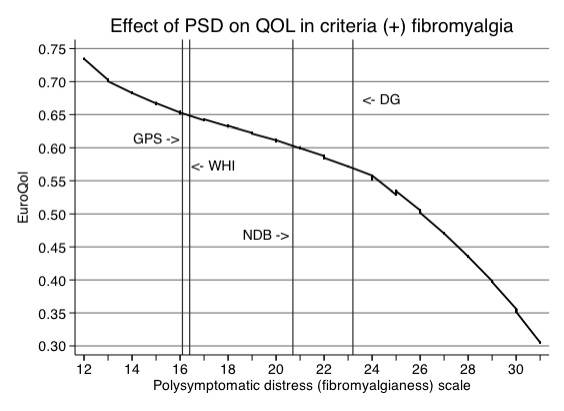Session Information
Session Type: Abstract Submissions (ACR)
Background/Purpose: The 2010 American College of Rheumatology (ACR) fibromyalgia (FM) criteria created a scale for the measurement of severity of pain extent—the 0-19 Widespread Pain Index (WPI), and a symptom scale—the 0-12 Symptom Severity scale (SS). Subsequent research and clinic usage combined the scales by summing them into the polysymptomatic distress (PSD) or fibromyalgianess scale, a 0-31 overall measure of pain extent and symptom distress. We investigated the value of the PSD scale in capturing severity of illness, and also applied the PSD scale to determine relative severity of subjects with criteria (+) FM in different settings: epidemiological studies – 844 persons in the Women’s Health Initiative (WHI) and 52 in the German general population (GPS), and in clinical studies – 1036 patients from the National Data Bank for Rheumatic Diseases (NDB) study of FM, and 64 from the tertiary referral practice of Dr. Don Goldenberg (DG). We hypothesized that DG’s patients would have the most severe FM and persons in the GPS epidemiological study the least severe FM. We also investigated whether values of the PSD would have clinical relevance as measures of severity.
Methods: We measured the mean scores of PSD in ACR 2010 (survey) criteria (+) FM subjects. We calculated the SF-36 Physical and Mental Component Summary scores (PCS/MCS), the EuroQol quality of life score, the Health Assessment Questionnaire (HAQ) functional disability score, the VAS pain scale, and the percentage of disabled patients, using data from the NDB at the 4 quartiles of the PSD.
Results: Severity of illness was related to PSD scores (Table 1) and Figure 1, and patients with higher mean PSD scores and in higher PSD quartiles demonstrated more severe illness. The quartile differences were large and clinically significant, and can also be seen clearly in the figure. By PSD, persons in the community (GPS and WPI) had the least severe illness, while illness was most severe in the tertiary referral practice (DG). From left to right, vertical lines in the figure represent PDS means for GPS, WHI, NDB and DG.
Conclusion: There is a considerable range of severity that can be observed among FM patients, and the PSD appears to be an easy-to-use assessment tool. Thus, much of the difference between patients is hidden when we simply diagnose FM. Patients in clinical practice have greater severity of illness compared with community subjects. This information regarding differential severity in the community compared with practice, sheds light on the role of self-selection and self-referral, and allows placing clinical and epidemiological data into perspective.
|
Quartile (Range) |
PSD |
SF-36 PCS |
SF-36 MCS |
EuroQol |
HAQ |
VAS Pain |
Disabled (%) |
|
Q1 (12-16) |
14.5 |
32.5 |
41.5 |
0.66 |
1.05 |
5.5 |
25 |
|
Q2 (17-20) |
18.4 |
31.2 |
39.8 |
0.61 |
1.18 |
5.9 |
30 |
|
Q3 (21-25) |
23.2 |
29.3 |
40.0 |
0.59 |
1.29 |
6.5 |
36 |
|
Q4 (26-31) |
28.0 |
27.5 |
34.5 |
0.43 |
1.59 |
7.4 |
43 |
Disclosure:
F. Wolfe,
None;
D. L. Goldenberg,
Pfizer Inc,
5;
B. T. Walitt,
None;
W. Häuser,
Pfizer Inc,
5,
Daiichi Pharmaceutical Corporation,
5,
Abbott Laboratories,
5.
« Back to 2013 ACR/ARHP Annual Meeting
ACR Meeting Abstracts - https://acrabstracts.org/abstract/the-polysymptomatic-distress-scale-as-a-measure-of-disease-and-practice-severity-in-fibromyalgia/

